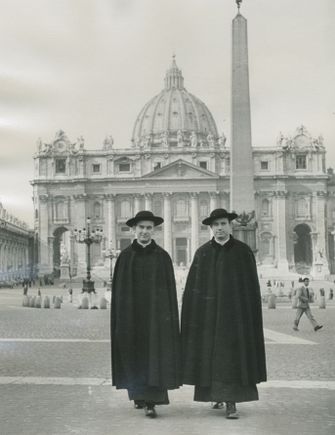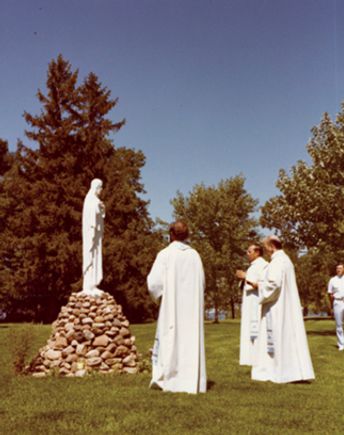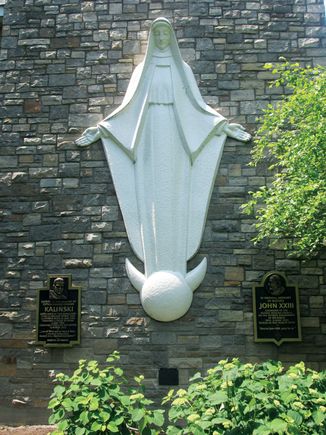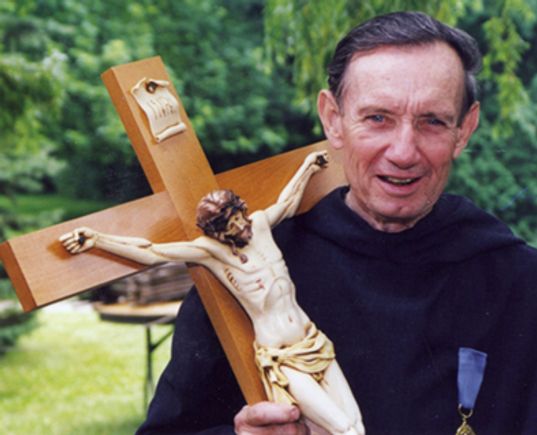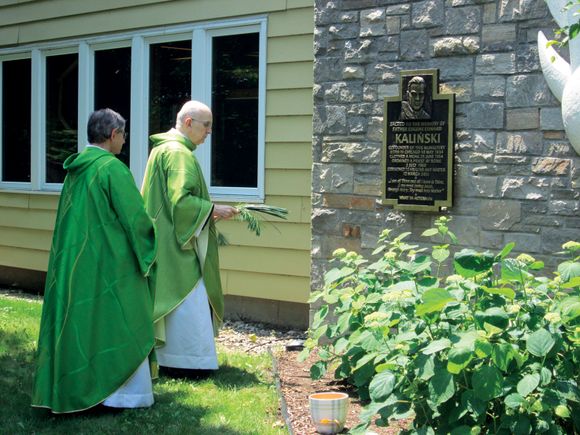NE PLUS ULTRA—Confluence and Culmination
The Wolf and Fox Rivers in Northeastern Wisconsin meet as one to form Lake Butte des Morts. From there, the Fox flows through the city of Oshkosh and into the imposing Lake Winnebago. Then it courses northward to carve the Fox Valley up to Green Bay to reach Lake Michigan. The Monastery of Our Lady came to be situated upon a nearly four-acre peninsula known as Oakwood Point on the south shore of Butte des Morts, two miles west of Oshkosh. The lake’s French name means “Mounds of the Dead” because the ancient Native Americans buried their dead beneath mounds in the shape of birds, reptiles, and circles close to the shoreline to face the setting sun. Sadly, the passage of time has eroded all traces of these burial mounds save for a small marker. The city bears the name of the Chief of the Menominee Nation, Oshkosh.
There on Oakwood Point in July of 1969, three priest-monks professed according to the Rule of Saint Benedict: Fathers Regis N. Barwig, Eugene E. Kalinski, and Augustine H. Serafini, would find, at the suggestion of the Bishop of Green Bay, Bishop Aloysius John Wycislo, a rambling, two-story, wood-frame dwelling for sale. The house ran from North to South on the prehistoric site of a native Fox village. In 1730, the French slaughtered the entire Fox Nation in a battle over furs. The unoccupied house was long-neglected but spacious. It stood at the water’s edge, and by night, the North Star hovered above in Ursa Major. A decades old guest house was also on the property. With the aid of God’s own compass, the three monks had found their site. They need go no further—the long journey’s end. However, with only 1/16th of the price to deposit, they had to scrape up loans and a mortgage to complete the sale and funds for extensive repairs. The bishop gave only his blessing. God provides!
This unusual Community, however, was an “idea” generated by an ideal—the Benedictine ideal—Pax, Peace. God’s peace: peace of heart, peace in the brotherhood, peace in the Church, peace among the Churches, peace among nations. The monastic ideal also looks toward peace among religions—an ideal vividly enunciated by Pope Francis in a document signed along with the Grand Imam of Al-Azhar in Abu Dhabi in early 2019: the Document on Human Fraternity for World Peace and Living Together.
In 1924, Pope Pius XI appealed to the Benedictines of the world as being most suited to engage in ecumenical relations with the Christian Churches of the East because these Churches were very much immersed in the culture of monasticism. Fathers Regis, Eugene, and Augustine had been inspired both by the ideals of Pax Benedictina and Christian Unity—that all may be one—John 17:21. They left the Benedictine Confederation in order to establish a new kind of monastic community that would pursue St. Benedict’s principles of prayer and work—the worship and seeking of God, as well as working for the monastery and for the needs of the Church, the People of God, and the unity of Christians in the contemporary world. Pope John XXIII by convoking Vatican Council II with his opening to the Eastern Orthodox, other Christian denominations, and the Jews animated the monks’ proposed apostolate.
Community Beginnings
The three monks went to Rome to request the blessing of Pope Paul VI for their plan. At the Easter Vigil, April 13, 1968, Fr. Regis spoke to the pope, now St. Paul VI, who willingly approved and told him to seek out a bishop who would grant permission for the foundation. While in Europe, they took the opportunity to visit the Ecumenical Patriarch Athenagoras I in Istanbul. On April 3, 1968, he welcomed and embraced them as “My spiritual grandsons!” The Patriarch encouraged them to continue their prayer and work for Christian unity; this would become one of the central aims of the community they hoped to establish. It was in ancient Byzantium, later Constantinople, that the first community meeting was held. The next three meetings took place in Vaduz in the remote Alpine Principality of Liechtenstein, on May 14-16. They discussed the formation of a Charter of Principles meant to ensure the living out of their monastic calling while engaging with the diocesan clergy and laity, and fully participating in the life of the universal Church. There they agreed upon a distinctively unadorned title for the new entity—Community of Our Lady—inspired by Notre Dame in Paris, “Our Lady” in English, a title adopted by numerous churches and institutions.
The Awe-inspiring Black Madonna
The three monks made a pilgrimage to one of the best-known shrines of Our Lady, Jasna Góra—the Bright Mountain—in Częstochowa. It was decided that She would be the “Our Lady” to which the Community would be dedicated. May 3rd was also the pilgrimage day of the nation with at least 100,000 people and all the bishops of Poland celebrating the feast of the Black Madonna—Queen of the Crown of Poland. The Cold War and persecution of the Catholic Church in the East was relentless. At that very moment, Soviet Russian tanks were poised on the border of the former Czechoslovakia. They met twice with the Cardinal Primate of Poland Stefan Wyszyński, and were the guests of the Metropolitan Archbishop of Poznań, Antony Baraniak who presented them with the hand-painted canvas of the Black Madonna blessed by the bishops of the country. The painting is the focus of the Marian shrine in the rustic chapel of the monastery, including a stone from the wall of Jasna Góra.
Toward Christian Unity
During their final days in Europe, Fathers Regis, Eugene, and Augustine were received by the Anglican Archbishop of Canterbury, Dr. Michael Arthur Ramsey. He too encouraged them to pursue their work for Christian unity. As the 800th anniversary of the martyrdom of St. Thomas Becket approached (1970) they chose St. Thomas Becket as their Patron Secondary. Enshrined in the chapel is a miniature bust of the archbishop, monk, and martyr carved by one of the monks. Dr. Ramsey also sent a stone from Canterbury Cathedral now enshrined on the outer wall of the monastery. At the request of Archbishop William Cousins of Milwaukee, Fr. Regis already had assisted in the organization of the Festival of Faith in southern Wisconsin.
It seemed no mere coincidence that monastic Community began its ecumenical outreach from Oshkosh by meeting with the Anglican Bishop of Fond du Lac, William Hampton Brady, residing in the Wisconsin city immediately south of Oshkosh. The Anglican/Episcopal Church in this region of America was overwhelmingly Anglo-Catholic in its theology, sacramental life, and ritual. Close ties were established with the priests and the Holy Nativity Sisters of the Fond du Lac Diocese. Annual conferences discussing Christian unity, theology, religious life, and contemporary problems and issues in the Church universal, were started at the monastery in Oshkosh early on. Orthodox, Lutheran, Anglicans, and Catholics participated. A major representative of Orthodoxy in attendance was the foundress of the Monastery of the Transfiguration in Elwood City, Pennsylvania, the Abbess Alexandra, formerly, the Princess Ileana of Romania. Mother Alexandra made annual visits to the Oshkosh monastery until the very end of her life. She was able, before death, to revisit the terribly persecuted land from which she was exiled so many decades earlier.
The New Monastery of Our Lady
The monks of the new community observed the Benedictine Rule and monastic vows and habits, but its official establishment as a religious society and monastery was the competence of the Catholic Bishop of Green Bay. He gave it the canonical status of Pia Unio, Pius Union, but now known as an Association of the Faithful. As priests of the Diocese of Green Bay, the monks began at once to assist the local clergy in parishes throughout the diocese that stretched from Green Bay down to border of the Milwaukee Archdiocese in the South and, to the borders of the La Crosse and Madison Dioceses to the West. The monks chose Fr. Regis as prior of the monastery. He appointed Fr. Eugene treasurer with responsibility for maintenance of the house and grounds including the laborious work of snow removal; and Fr. Augustine as secretary—who also willingly assumed the role of cook claiming that Italian roots make him a natural cook. In 2012, the community suffered a great loss with the death of Fr. Eugene Kalinski. His kindness, cheerfulness, and wisdom are remembered by a good many friends even after nearly a decade.
Conferences and lectures concerning Church history, theology, spirituality, Church Fathers, and contemporary issues were held for parishioners from the surrounding towns. Days of recollection and pilgrimages were held for young and old from Wisconsin and other states. Many may not be familiar with the marked disparity in theological issues, and the abandonment of the sacred and religious life and devotion characteristic of the 1970s and 80s. By encouragement, counseling, and witness; and with its concelebration of the Mass and Liturgy—always according to the spirit and model newly established by Pope Paul VI—but in the monastic setting—the Monastery of Our Lady became an island of peace, not only in the Diocese of Green Bay, but also for not a few souls in America and other countries too. Individuals sought spiritual counsel and advice; others received instruction for reception into the Church. Cardinal Józef Glemp, Primate of Poland, came to Oshkosh to bless the Community in 1998, accompanied by Msgr. Andrzej Dziuba, now Bishop of Łowicz near Warsaw.
Fr. Regis was asked to direct countless retreats for Sisters, priests, and laity in the United States. He published original works and edited and translated important works. Fr. Augustine led catechism classes for primary and secondary school children; and also published two books and many articles. Together, the monks established friendly relations with individuals of all faiths and walks of life through their writings and projects.
NE PLUS ULTRA is the motto of the Community of Our Lady. A motto epitomizes a particular aspiration or personal devotion, and speaks of a faith, hope, or ideal that extends beyond this transitory life.
NE PLUS ULTRA is an expression alleged to have been inscribed on the Pillars of Hercules. It meant simply, the realization of the utmost limit to which one might go, the point of high achievement, the acme and final attainment and culmination. In the past this motto had been applied to “unsurpassable persons.”
NE PLUS ULTRA indeed means our Pillars of Strength, the Divine Savior and the Mother of God who await us on the shores of Light and Peace.
The Wolf and Fox Rivers in Northeastern Wisconsin meet as one to form Lake Butte des Morts. From there, the Fox flows through the city of Oshkosh and into the imposing Lake Winnebago. Then it courses northward to carve the Fox Valley up to Green Bay to reach Lake Michigan. The Monastery of Our Lady came to be situated upon a nearly four-acre peninsula known as Oakwood Point on the south shore of Butte des Morts, two miles west of Oshkosh. The lake’s French name means “Mounds of the Dead” because the ancient Native Americans buried their dead beneath mounds in the shape of birds, reptiles, and circles close to the shoreline to face the setting sun. Sadly, the passage of time has eroded all traces of these burial mounds save for a small marker. The city bears the name of the Chief of the Menominee Nation, Oshkosh.
There on Oakwood Point in July of 1969, three priest-monks professed according to the Rule of Saint Benedict: Fathers Regis N. Barwig, Eugene E. Kalinski, and Augustine H. Serafini, would find, at the suggestion of the Bishop of Green Bay, Bishop Aloysius John Wycislo, a rambling, two-story, wood-frame dwelling for sale. The house ran from North to South on the prehistoric site of a native Fox village. In 1730, the French slaughtered the entire Fox Nation in a battle over furs. The unoccupied house was long-neglected but spacious. It stood at the water’s edge, and by night, the North Star hovered above in Ursa Major. A decades old guest house was also on the property. With the aid of God’s own compass, the three monks had found their site. They need go no further—the long journey’s end. However, with only 1/16th of the price to deposit, they had to scrape up loans and a mortgage to complete the sale and funds for extensive repairs. The bishop gave only his blessing. God provides!
This unusual Community, however, was an “idea” generated by an ideal—the Benedictine ideal—Pax, Peace. God’s peace: peace of heart, peace in the brotherhood, peace in the Church, peace among the Churches, peace among nations. The monastic ideal also looks toward peace among religions—an ideal vividly enunciated by Pope Francis in a document signed along with the Grand Imam of Al-Azhar in Abu Dhabi in early 2019: the Document on Human Fraternity for World Peace and Living Together.
In 1924, Pope Pius XI appealed to the Benedictines of the world as being most suited to engage in ecumenical relations with the Christian Churches of the East because these Churches were very much immersed in the culture of monasticism. Fathers Regis, Eugene, and Augustine had been inspired both by the ideals of Pax Benedictina and Christian Unity—that all may be one—John 17:21. They left the Benedictine Confederation in order to establish a new kind of monastic community that would pursue St. Benedict’s principles of prayer and work—the worship and seeking of God, as well as working for the monastery and for the needs of the Church, the People of God, and the unity of Christians in the contemporary world. Pope John XXIII by convoking Vatican Council II with his opening to the Eastern Orthodox, other Christian denominations, and the Jews animated the monks’ proposed apostolate.
Community Beginnings
The three monks went to Rome to request the blessing of Pope Paul VI for their plan. At the Easter Vigil, April 13, 1968, Fr. Regis spoke to the pope, now St. Paul VI, who willingly approved and told him to seek out a bishop who would grant permission for the foundation. While in Europe, they took the opportunity to visit the Ecumenical Patriarch Athenagoras I in Istanbul. On April 3, 1968, he welcomed and embraced them as “My spiritual grandsons!” The Patriarch encouraged them to continue their prayer and work for Christian unity; this would become one of the central aims of the community they hoped to establish. It was in ancient Byzantium, later Constantinople, that the first community meeting was held. The next three meetings took place in Vaduz in the remote Alpine Principality of Liechtenstein, on May 14-16. They discussed the formation of a Charter of Principles meant to ensure the living out of their monastic calling while engaging with the diocesan clergy and laity, and fully participating in the life of the universal Church. There they agreed upon a distinctively unadorned title for the new entity—Community of Our Lady—inspired by Notre Dame in Paris, “Our Lady” in English, a title adopted by numerous churches and institutions.
The Awe-inspiring Black Madonna
The three monks made a pilgrimage to one of the best-known shrines of Our Lady, Jasna Góra—the Bright Mountain—in Częstochowa. It was decided that She would be the “Our Lady” to which the Community would be dedicated. May 3rd was also the pilgrimage day of the nation with at least 100,000 people and all the bishops of Poland celebrating the feast of the Black Madonna—Queen of the Crown of Poland. The Cold War and persecution of the Catholic Church in the East was relentless. At that very moment, Soviet Russian tanks were poised on the border of the former Czechoslovakia. They met twice with the Cardinal Primate of Poland Stefan Wyszyński, and were the guests of the Metropolitan Archbishop of Poznań, Antony Baraniak who presented them with the hand-painted canvas of the Black Madonna blessed by the bishops of the country. The painting is the focus of the Marian shrine in the rustic chapel of the monastery, including a stone from the wall of Jasna Góra.
Toward Christian Unity
During their final days in Europe, Fathers Regis, Eugene, and Augustine were received by the Anglican Archbishop of Canterbury, Dr. Michael Arthur Ramsey. He too encouraged them to pursue their work for Christian unity. As the 800th anniversary of the martyrdom of St. Thomas Becket approached (1970) they chose St. Thomas Becket as their Patron Secondary. Enshrined in the chapel is a miniature bust of the archbishop, monk, and martyr carved by one of the monks. Dr. Ramsey also sent a stone from Canterbury Cathedral now enshrined on the outer wall of the monastery. At the request of Archbishop William Cousins of Milwaukee, Fr. Regis already had assisted in the organization of the Festival of Faith in southern Wisconsin.
It seemed no mere coincidence that monastic Community began its ecumenical outreach from Oshkosh by meeting with the Anglican Bishop of Fond du Lac, William Hampton Brady, residing in the Wisconsin city immediately south of Oshkosh. The Anglican/Episcopal Church in this region of America was overwhelmingly Anglo-Catholic in its theology, sacramental life, and ritual. Close ties were established with the priests and the Holy Nativity Sisters of the Fond du Lac Diocese. Annual conferences discussing Christian unity, theology, religious life, and contemporary problems and issues in the Church universal, were started at the monastery in Oshkosh early on. Orthodox, Lutheran, Anglicans, and Catholics participated. A major representative of Orthodoxy in attendance was the foundress of the Monastery of the Transfiguration in Elwood City, Pennsylvania, the Abbess Alexandra, formerly, the Princess Ileana of Romania. Mother Alexandra made annual visits to the Oshkosh monastery until the very end of her life. She was able, before death, to revisit the terribly persecuted land from which she was exiled so many decades earlier.
The New Monastery of Our Lady
The monks of the new community observed the Benedictine Rule and monastic vows and habits, but its official establishment as a religious society and monastery was the competence of the Catholic Bishop of Green Bay. He gave it the canonical status of Pia Unio, Pius Union, but now known as an Association of the Faithful. As priests of the Diocese of Green Bay, the monks began at once to assist the local clergy in parishes throughout the diocese that stretched from Green Bay down to border of the Milwaukee Archdiocese in the South and, to the borders of the La Crosse and Madison Dioceses to the West. The monks chose Fr. Regis as prior of the monastery. He appointed Fr. Eugene treasurer with responsibility for maintenance of the house and grounds including the laborious work of snow removal; and Fr. Augustine as secretary—who also willingly assumed the role of cook claiming that Italian roots make him a natural cook. In 2012, the community suffered a great loss with the death of Fr. Eugene Kalinski. His kindness, cheerfulness, and wisdom are remembered by a good many friends even after nearly a decade.
Conferences and lectures concerning Church history, theology, spirituality, Church Fathers, and contemporary issues were held for parishioners from the surrounding towns. Days of recollection and pilgrimages were held for young and old from Wisconsin and other states. Many may not be familiar with the marked disparity in theological issues, and the abandonment of the sacred and religious life and devotion characteristic of the 1970s and 80s. By encouragement, counseling, and witness; and with its concelebration of the Mass and Liturgy—always according to the spirit and model newly established by Pope Paul VI—but in the monastic setting—the Monastery of Our Lady became an island of peace, not only in the Diocese of Green Bay, but also for not a few souls in America and other countries too. Individuals sought spiritual counsel and advice; others received instruction for reception into the Church. Cardinal Józef Glemp, Primate of Poland, came to Oshkosh to bless the Community in 1998, accompanied by Msgr. Andrzej Dziuba, now Bishop of Łowicz near Warsaw.
Fr. Regis was asked to direct countless retreats for Sisters, priests, and laity in the United States. He published original works and edited and translated important works. Fr. Augustine led catechism classes for primary and secondary school children; and also published two books and many articles. Together, the monks established friendly relations with individuals of all faiths and walks of life through their writings and projects.
NE PLUS ULTRA is the motto of the Community of Our Lady. A motto epitomizes a particular aspiration or personal devotion, and speaks of a faith, hope, or ideal that extends beyond this transitory life.
NE PLUS ULTRA is an expression alleged to have been inscribed on the Pillars of Hercules. It meant simply, the realization of the utmost limit to which one might go, the point of high achievement, the acme and final attainment and culmination. In the past this motto had been applied to “unsurpassable persons.”
NE PLUS ULTRA indeed means our Pillars of Strength, the Divine Savior and the Mother of God who await us on the shores of Light and Peace.


